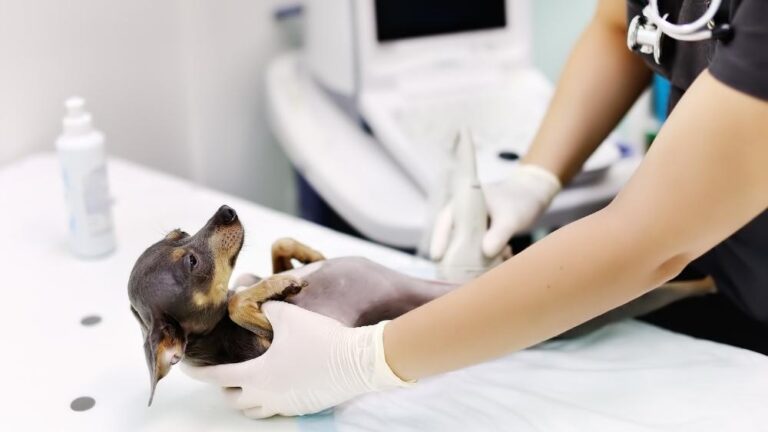Dog pregnancy typically lasts about 63 days or 9 weeks. However, a dog’s gestation period can vary slightly depending on several factors. In this post, we will explore the length of a dog’s pregnancy, the factors that can affect it, and what to expect during this time.
How Long Are Dogs Pregnant?
A dog’s gestation period is the time from conception to delivery, and it is an essential aspect to consider when preparing for a litter of puppies. On average, the gestation period for dogs is around 63 days or approximately two months, but this can vary depending on factors such as breed, age, and size of the dog, as well as the size of the litter.
Smaller dogs generally have shorter gestation periods than larger dogs and larger litters can result in shorter gestation periods. During gestation, the dog’s body undergoes significant changes to support the growing puppies. It is important to provide proper care and nutrition to the mother during this time. This includes feeding a high-quality diet designed for pregnant or nursing dogs, providing ample space and exercise, and ensuring regular veterinary check-ups to monitor the mother’s health and the development of the puppies.
By understanding a dog’s gestation period and providing proper care during this time, you can help ensure a healthy pregnancy and successful delivery of a litter of puppies. It is also crucial to prepare for the delivery by creating a comfortable and safe environment for the mother and her puppies. This includes providing a whelping box, clean bedding, and appropriate supplies for the delivery.
Factors Affecting Dog Pregnancy

Several factors can influence the length of a dog’s pregnancy. These include:
- Breed: The size and breed of a dog can play a role in the length of pregnancy. Smaller dogs tend to have shorter pregnancies, while larger dogs may have longer ones. For example, Chihuahuas may have a gestation period of around 58 to 63 days, while Great Danes may have a gestation period of up to 68 days.
- Litter Size: The number of puppies a dog carries can also affect the length of pregnancy. A larger litter can result in a shorter pregnancy, while a smaller one may lead to a longer pregnancy. This is because the mother’s body needs to accommodate the growing fetuses, and a larger litter can lead to faster development and readiness for birth.
- Age and Health of the Mother: The age and overall health of the mother can also affect the length of pregnancy. Older dogs may have shorter pregnancies, while younger dogs may have longer ones. The mother’s body may not be as efficient in supporting pregnancy in old age, while younger dogs may take longer to develop and prepare for birth. Health issues such as poor nutrition, infections, or medical conditions can also lead to complications and affect the length of pregnancy.
- Genetics: Genetics can also affect the length of a dog’s pregnancy. Certain breeds are predisposed to shorter or longer gestation periods. For example, Doberman Pinschers typically have shorter pregnancies than Dalmatians.
Overall, monitoring your dog’s health and behavior throughout pregnancy is important, and seeking veterinary care if any concerns arise. With proper care, most dogs have successful pregnancies and give birth to healthy puppies.
What to Expect During Dog Pregnancy

During the first few weeks of pregnancy, there may not be any visible signs of pregnancy. However, as the pregnancy progresses, some of the common signs include:
- Increased Appetite: As the pregnancy progresses, you may notice that your dog’s appetite increases. This is because the growing fetuses require more nutrition, and the mother’s body needs to support their development.
- Nipple Growth and Darkening: The dog’s nipples may become larger and darker in color, indicating that they are preparing for milk production to feed the newborn puppies.
- Behavioral Changes: You may notice that your dog’s behavior changes during pregnancy. This can include restlessness, nesting behavior, and seeking more attention from their owner.
- Weight Gain: The mother’s body weight will increase as the puppies grow and develop. It’s important to monitor her weight and ensure she gets enough exercise and a balanced diet to maintain her health.
- Enlarged Abdomen: As the pregnancy progresses, the dog’s abdomen will become larger as the puppies grow and develop.
- Signs of Labor: As the pregnancy nears its end, you may notice that your dog becomes more restless, panting, and displaying nesting behavior. The dog may also have a clear, odorless discharge from the vagina, indicating that labor is imminent.
- Vomiting: Some dogs may experience mild to moderate vomiting during the first few weeks of pregnancy. This is due to hormonal changes and typically resolves on its own.
It’s important to monitor your dog’s behavior and health throughout pregnancy and consult a veterinarian if any concerns arise. A veterinarian can also guide proper prenatal care and delivery.
Post-Pregnancy Care
After giving birth, the mother dog and her puppies will require special care. Here are some tips for post-pregnancy care of a dog:
- Monitor the Mother and Puppies: After delivery, monitor the mother and puppies to ensure they are all healthy and thriving. Ensure that the puppies are nursing and gaining weight. Look for signs of distress, such as lethargy or loss of appetite.
- Provide Proper Nutrition: The mother will need to continue to eat a well-balanced diet to support milk production and recovery. Consult with a veterinarian to ensure the mother gets the proper nutrition and supplements.
- Provide a Clean and Safe Environment: Ensure the mother and puppies have a clean and safe environment. Clean bedding, a warm temperature, and a secure space can help promote health and well-being.
- Schedule Postnatal Check-Ups: Schedule a postnatal check-up with a veterinarian to ensure the mother and puppies are healthy and recovering well.
- Vaccinations and Deworming: Ensure the mother and puppies are up-to-date on vaccinations and deworming. This can help prevent the spread of diseases and parasites.
- Gradual Exercise: Gradually reintroduce exercise to the mother as she recovers from delivery. Too much exercise too soon can be harmful to her health.
- Spaying: Consider spaying the mother to prevent future pregnancies and reduce the risk of certain medical conditions.
Overall, post-pregnancy care is crucial for the health and well-being of the mother and puppies. Regular veterinary care, proper nutrition, and a clean environment can help ensure a successful recovery.
The Stages of a Dog’s Pregnancy
A dog goes through three different stages during its pregnancy leading up to the birth of its puppies. It is a quick pregnancy; a healthy dog should be fine having two pregnancies a year if well looked after. A dog has been pregnant for just over two months.
- Stage 1:
The first stage of pregnancy is the fertilization of the eggs. This usually occurs during breeding, and it can be difficult to determine the exact day that it happened. During this stage, there may not be any physical signs of pregnancy.
- Stage 2:
The second stage of pregnancy is the embryonic stage. This stage typically lasts between 14 to 21 days. During this time, the fertilized eggs travel to the uterus and implant themselves in the uterine lining. At this point, the embryos are tiny and cannot be felt through palpation or ultrasound.
- Stage 3:
The third stage of pregnancy is the fetal stage. This stage begins after the embryos are implanted in the uterine lining and continue until birth. The embryos develop into fully formed fetuses with recognizable features during this stage. This stage is usually between 42 to 45 days long.
- Stage 4:
The fourth stage of pregnancy is the final stage leading up to delivery. This stage usually lasts around two weeks. During this time, the dog’s belly will become noticeably larger as the puppies grow and develop. The dog may also experience a decrease in appetite, become more restless, and exhibit nesting behavior as she prepares for delivery.
- Stage 5:
The fifth and final stage of pregnancy is delivery. This is when the puppies are born. Delivery can last anywhere from a few hours to a full day, depending on the size of the litter and the individual dog. During delivery, the dog will experience contractions as she works to push out each puppy. After all the puppies have been delivered, the dog will continue to have contractions as she delivers the placenta.
It’s crucial to monitor her health and behavior closely throughout every stage of pregnancy To ensure a healthy and successful pregnancy and delivery for your dog and her puppies.
Seeking guidance from a veterinarian for proper prenatal care and delivery is also essential. Giving your dog proper care and attention throughout pregnancy can help achieve these goals.
How Long Are Dogs in Labor?
Labor for dogs is divided into three stages: the first stage, the second stage, and the third stage. The first stage of labor can last between 12 to 24 hours or longer, depending on the individual dog. During this stage, the dog may appear restless, pant heavily, and exhibit nesting behavior as her cervix dilates. The dog may also have a clear, odorless discharge from the vagina during this stage.
The second stage of labor is when active labor begins. During this stage, the dog will have strong and regular contractions as she works to push out each puppy. This stage typically lasts 6 to 12 hours, although some dogs may have a shorter or longer active labor period. During this stage, the dog may appear more anxious or in pain and vocalize as she pushes out each puppy. It’s important to monitor the dog’s behavior during this stage and contact a veterinarian for any concerns.
The third stage of labor is when the dog delivers the placenta or afterbirth. This usually happens shortly after each puppy is born, but in some cases, the dog may deliver several placentas at once. It’s important to ensure all the placentas are delivered, as retained placentas can lead to infections and other complications.
During the labor process of your dog, it is crucial to observe their health and behavior closely. If any complications arise, it’s essential to seek veterinary attention.
Signs of a problem during labor can include prolonged labor, weak contractions, difficulty delivering a puppy, or any signs of distress in the mother or puppies. By providing proper care and attention during labor, you can help ensure successful delivery for the mother and her puppies.
Conclusion
The gestation period for dogs is an important factor to consider when preparing for a new litter of puppies. On average, the gestation period for dogs is around 63 days or approximately two months from the date of conception. However, this can vary depending on factors such as the breed, age, and size of the dog and the litter.
When your dog is pregnant, monitoring her behavior and health regularly is crucial, and keeping track of the due date. By providing appropriate care and nutrition to the mother, you can increase the chances of a healthy pregnancy and delivery.
It’s also important to seek veterinary attention if complications arise during pregnancy or labor. Understanding how long dogs are pregnant and proper care during pregnancy can help ensure a healthy and successful pregnancy and delivery for your furry friend.




